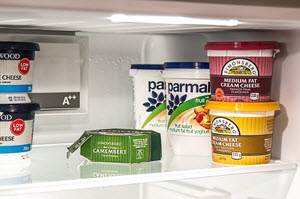Does Freezing Food Kill Bacteria?
Posted on 1st Dec 2017

Many consumers, as well as professionals in the food service industry, believe that freezing food (for instance, leftovers or food items not used or served in a restaurant) will kill off germs and bacteria. Plus, some believe that food can stay in the freezer virtually indefinitely, although the taste and texture of the food may deteriorate over time, mainly due to ice crystal damage.
One of the many reasons why this is believed is because water in the food items is also frozen. Germs and bacteria are dependent on moisture for their survival.
However, these assumptions can have dire health consequences. Freezing does not kill germs and bacteria. Instead, it essentially puts them into hibernation. They are inactive while the food is frozen and will “wake up” as soon as the food thaws. And as the food thaws, so will the moisture, which means the bacteria will have the moisture it needs to survive.
But there is more to the story. Refrozen food has a higher risk of causing food poisoning, according to the Food Standards Agency, an independent government department serving parts of Wales, Ireland, and countries within the European Union. Often this is because the bacteria have gone into a type of remission when frozen. However, once it is thawed, and especially if it is allowed to stay at room temperatures, the bacteria return with a vengeance.
So how can we protect ourselves? Instead of freezing leftover or unused food times, does this mean everything needs to be tossed out? Not necessarily.
“If you cook defrosted food before freezing (for example, turning defrosted chicken into a chicken curry), any harmful bugs will be killed off, making the food safe before freezing,” says Lorna Rowswell, from the hygiene and microbiology team at the Food Standards Agency. “[Further], any defrosted food can be stored in the fridge for up to two days before it needs to be cooked or thrown away.”
While these guidelines will serve both the consumer and professionals in the foodservice industry, those in the industry have much more at stake. They are preparing food items for hundreds, if not thousands of people. This means they must take extra precautions to ensure the food they prepare is safe to eat and free of harmful bacteria.
This typically starts by monitoring temperatures in refrigerators and freezers. For instance, if food in the freezer is not stored at a low enough temperature, then germs and bacteria may continue growing, potentially making the food item even more likely to cause illness or food poisoning.
Further, Rowswell says that defrosted food can be stored in a refrigerator for up to two days before it must be cooked or tossed away. But what if, once again, our refrigerator is not keeping the food cold enough to prevent spoilage? Instead of two days, the food may be spoiled within 24 hours or less.
This can happen even when the temperature settings of the freezer and refrigerator are set to ensure food safety. Because of this, we cannot depend on those settings, but need independent, continuous monitoring systems to ensure food is kept at the right temperature at all times.
Fortunately, Hawk Safety, which has just joined the DayMark Safety Systems family, provides technologies that track and ensure that temperatures in freezers and refrigerators are correct, keeping food safe. Using sensors, if temperatures drift outside a pre-defined temperature range, food service professionals are notified immediately, with alerts sent to one or more smartphones or computer systems.
This protects health, prevents spoilage, and can be a major cost savings for the entire foodservice industry.
For more information on ways to keep food safe and healthy, contact a DayMark representative at 800-517-0490.


